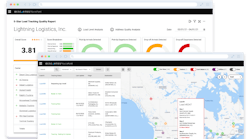Though it has been a long time coming in Canada, an electronic logging device (ELD) mandate similar to the one in the U.S. is poised to be issued by the close of 2017 if all goes as planned.
Geoff Wood, senior vice president of policy for the Canadian Trucking Alliance (CTA), explained during a presentation here at the TMW System and PeopleNet's 2017 in.sight user conference and exposition that a draft of Canada’s version of an ELD mandate – which will be “99.8% in line” with the rule promulgated by the Federal Motor Carrier Safety Administration (FMCSA) – should be published sometime this fall.
He expects that draft to be quickly approved, as the technical standards have been in development for six years now, with a final rule likely to be issued by the end of 2017.
Technically, Canada's ELD rule is actually an amendment to its federal hours of service (HOS) regulations, not a separate rule in and of itself. And it will be published in two stages via the Canada Gazette, which is analogous to the Federal Register in the U.S. - the first stage being in the proposed or "Gazette I" category and then the final version in the "Gazette II" section, where finalized regulations are announced.
If published as expected, the deadline for compliance with Canada’s ELD mandate would be by December of 2019, with those using automatic onboard recording devices (AOBRDs) getting until 2021 to make the switch.
“We don’t expect a lot of surprise over this rule, partly because we’ve taken a lot of time to develop it,” Wood said. “We also needed more buy-in from the provincial governments as our federal rules work a little bit differently compared to here in the states.”
The rules of who is and who is not covered under Canada’s ELD mandate will mirror those in the U.S., he noted. Federally-regulated motor vehicles over 10,000 lbs. (equal to some some 4,500 kilograms in Canada) where the driver currently must maintain a paper logbook are covered. Exemptions are for truck rentals under 30 days and for drivers who stay within a 160 kilometer (about 99.14 miles) radius of home base – though those “short-range” drivers must still comply with hours of service (HOS) rules.Fleets operating under what are known as “federal HOS permits” are exempted as well, such as those serving in the oil fields and hauling dry or liquid fertilizer for farming.
“They can switch to using ELDs if they want to; they are just not being made mandatory for them,” Woods pointed out.
There are a few differences, however, between Canada’s soon-to-be proposed ELD mandate and the one on the books in the U.S., he added. Some of those are:
- In Canada’s case, the technical standards ELDs will be required to meet will only be referenced in its mandate; by contrast, such standards are embedded within the U.S. mandate.
- ELDs in Canada will be required on commercial vehicles back to the 1995 model year, as opposed to the 2000 model year cut off in the U.S. If that wasn’t done, Wood said some 65,000 to 70,000 trucks “would not be captured” by the ELD rule.
- There is a “deferral of off duty” option in the Canadian HOS rules that the U.S. does not have.
- Personnel use of the truck without activating the ELD will be allowed for less than 75 kilometers (some 46 miles) worth of travel.
However, Wood stressed that those differences aside, Canada’s ELD mandate will closely track what’s been established in the U.S.
“The long and short of it is, if you buy and use and U.S.-compliant device, you will have no issues in Canada,” he said.




